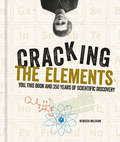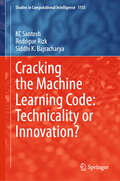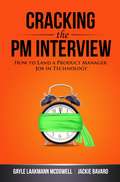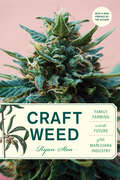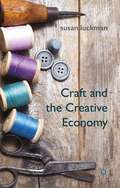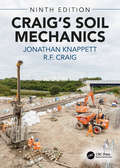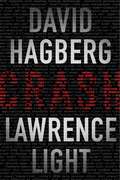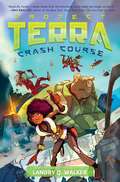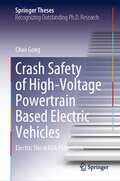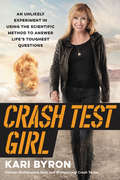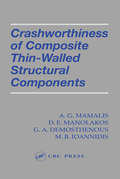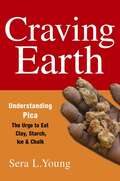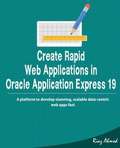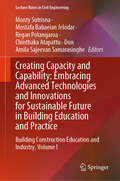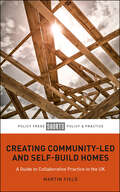- Table View
- List View
Cracking the Elements (Cracking Ser.)
by Rebecca MilehamFrom the earliest-known elements to those named in 2016, this book takes a comprehensive look at the development of the periodic table - and reveals untold stories, unsung pioneers and plenty of fascinating science along the way. In twelve illustrated chapters, the book makes sense of the patterns and groups within the periodic table, introducing each of the 118 known elements individually and exploring questions including:- Why did the history of fizzy water give early chemistry a sparkle?- How did hydrogen reveal the structure of the atom?- What was the Bunsen burner's role in discovering new elements?- Which of the alkaline earth metals accounts for a kilogramme of your weight?- Why is Marie Curie such a scientific star?- How do tungsten and vanadium explain the secret of super-sharp Syrian swords?- Who discovered the most elements in the periodic table?- What made nihonium, element 113, such a wonderful new year's gift for Japan?- Is glass a liquid or a solid?- How did nitrogen fulfill the alchemists' dream?- Would you have smeared antimony on your face if you'd lived in ancient Egypt?- Why might naked mole rats have clues for surviving a heart attack?- How did the Haya people of Tanzania make steel 1500 years ago?- What makes xenon a great anaesthetic - and why can't all patients use it?- Might there be a pattern in yet undiscovered elements beyond number 118?
Cracking the Elements (Cracking Series)
by Rebecca MilehamFrom the earliest-known elements to those named in 2016, this book takes a comprehensive look at the development of the periodic table - and reveals untold stories, unsung pioneers and plenty of fascinating science along the way. In twelve illustrated chapters, the book makes sense of the patterns and groups within the periodic table, introducing each of the 118 known elements individually and exploring questions including:- Why did the history of fizzy water give early chemistry a sparkle?- How did hydrogen reveal the structure of the atom?- What was the Bunsen burner's role in discovering new elements?- Which of the alkaline earth metals accounts for a kilogramme of your weight?- Why is Marie Curie such a scientific star?- How do tungsten and vanadium explain the secret of super-sharp Syrian swords?- Who discovered the most elements in the periodic table?- What made nihonium, element 113, such a wonderful new year's gift for Japan?- Is glass a liquid or a solid?- How did nitrogen fulfill the alchemists' dream?- Would you have smeared antimony on your face if you'd lived in ancient Egypt?- Why might naked mole rats have clues for surviving a heart attack?- How did the Haya people of Tanzania make steel 1500 years ago?- What makes xenon a great anaesthetic - and why can't all patients use it?- Might there be a pattern in yet undiscovered elements beyond number 118?
Cracking the Machine Learning Code: Technicality or Innovation? (Studies in Computational Intelligence #1155)
by KC Santosh Rodrigue Rizk Siddhi K. BajracharyaEmploying off-the-shelf machine learning models is not an innovation. The journey through technicalities and innovation in the machine learning field is ongoing, and we hope this book serves as a compass, guiding the readers through the evolving landscape of artificial intelligence. It typically includes model selection, parameter tuning and optimization, use of pre-trained models and transfer learning, right use of limited data, model interpretability and explainability, feature engineering and autoML robustness and security, and computational cost – efficiency and scalability. Innovation in building machine learning models involves a continuous cycle of exploration, experimentation, and improvement, with a focus on pushing the boundaries of what is achievable while considering ethical implications and real-world applicability. The book is aimed at providing a clear guidance that one should not be limited to building pre-trained models to solve problems using the off-the-self basic building blocks. With primarily three different data types: numerical, textual, and image data, we offer practical applications such as predictive analysis for finance and housing, text mining from media/news, and abnormality screening for medical imaging informatics. To facilitate comprehension and reproducibility, authors offer GitHub source code encompassing fundamental components and advanced machine learning tools.
Cracking the PM Interview: How to Land a Project Manager Job in Technology
by Gayle McDowell Jackie BavaroHow many pizzas are delivered in Manhattan? How do you design an alarm clock for the blind? What is your favorite piece of software and why? How would you launch a video rental service in India? This book offers proven tips on how to answer questions like these and more. Cracking the PM Interview is a comprehensive book about landing a product management role in a startup or bigger tech company. Learn how the ambiguously-named "PM" (product manager / program manager) role varies across companies, what experience you need, how to make your existing experience translate, what a great PM resume and cover letter look like, and finally, how to master the PM interview questions (estimation questions, behavioral questions, case questions, product questions, technical questions, and the super important "pitch").
Craft Weed, with a new preface by the author: Family Farming and the Future of the Marijuana Industry
by Ryan StoaHow the future of post-legalization marijuana farming can be sustainable, local, and artisanal.What will the marijuana industry look like as legalization spreads? Will corporations sweep in and create Big Marijuana, flooding the market with mass-produced weed? Or will marijuana agriculture stay true to its roots in family farming, and reflect a sustainable, local, and artisanal ethic? In Craft Weed, Ryan Stoa argues that the future of the marijuana industry should be powered by small farms—that its model should be more craft beer than Anheuser-Busch.To make his case for craft weed, Stoa interviews veteran and novice marijuana growers, politicians, activists, and investors. He provides a history of marijuana farming and its post-hippie resurgence in the United States. He reports on the amazing adaptability of the cannabis plant and its genetic gifts, the legalization movement, regulatory efforts, the tradeoffs of indoor versus outdoor farms, and the environmental impacts of marijuana agriculture. To protect and promote small farmers and their communities, Stoa proposes a Marijuana Appellation system, modeled after the wine industry, which would provide a certified designation of origin to local crops. A sustainable, local, and artisanal farming model is not an inevitable future for the marijuana industry, but Craft Weed makes clear that marijuana legalization has the potential to revitalize rural communities and the American family farm.As the era of marijuana prohibition comes to an end, now is the time to think about what kind of marijuana industry and marijuana agriculture we want. Craft Weed will help us plan for a future that is almost here.
Craft and the Creative Economy
by Susan LuckmanCraft and the Creative Economy examines the place of craft and making in the contemporary cultural economy, with a distinctive focus on the ways in which this creative sector is growing exponentially as a result of online shopfronts and home-based micro-enterprise, 'mumpreneurialism' and downshifting, and renewed demand for the handmade.
Crafting Innovative Places for Australia’s Knowledge Economy
by Edward J. Blakely Richard HuThis book integrates planning, policy, economics, and urban design into an approach to crafting innovative places. Exploring new paradigms of innovative places under the framework of globalisation, urbanisation, and new technology, it argues against state-centric policies to innovation and focuses on how a globalized approach can shape innovative capacity and competitiveness. It notably situates the innovative place making paradigm in a broader context of globalisation, urbanisation, the knowledge economy and technological advancement, and employs an international perspective that includes a wide range of case studies from America, Europe, Asia, and Australia. Developing a co-design and co-creation paradigm that integrates governments, the private sector and the community into shared understanding and collaborative action in crafting innovative places, it discusses place-based innovation in Australian context to inform policy making and planning, and to contribute to policy debates on programs of smart cities and communities.
Crafting Sustainability in Luxury Textiles for a Zero-Waste Future (Sustainable Textiles: Production, Processing, Manufacturing & Chemistry)
by Rajesh Kumar Sadhna E MokanaasriIn an era where environmental consciousness is rapidly becoming a priority, the luxury textile industry stands at a crucial crossroads. As consumers increasingly demand products that not only offer elegance and opulence but also align with sustainable values, luxury brands are facing a paradigm shift in their approach. This shift towards sustainability is not merely a trend but a fundamental reevaluation of the industry's practices, driven by a growing awareness of the environmental impact of textile manufacturing and consumption. This contributed volume explores this transformative journey, investigating how luxury and sustainability can harmoniously coexist to shape a future where opulence is synonymous with environmental stewardship. The book examines the intricate relationship between luxury textiles and sustainability, offering insights, analyses, and practical solutions for crafting a zero-waste future in the high-end fashion industry. The book serves as a valuable resource for scholars, practitioners, and policymakers seeking to navigate the complexities of sustainable textile production while maintaining the essence of luxury and craftsmanship. Through a collaborative effort, the work presented here sets the stage for a future where luxury textiles captivate the senses and inspire a profound sense of environmental responsibility, paving the way toward a zero-waste future in high-end fashion.
Craig's Soil Mechanics
by Jonathan Knappett R.F. CraigCraig’s Soil Mechanics continues to evolve and remain the definitive text for civil engineering students worldwide. It covers fundamental soil mechanics and its application in applied geotechnical engineering from A to Z and at the right depth for an undergraduate civil engineer, with sufficient extension material for supporting MSc level courses, and with practical examples and digital tools to make it a useful reference work for practising engineers. This new edition now includes: Restructured chapters on foundations and earthworks, the latter including new material on working platforms and collapse of underground cavities (sinkhole formation). New mobilised-stress-based deformation methods that can straightforwardly be used with both linear and non-linear soil stiffness models and field measurements of shear wave velocity, for serviceability limit state design. Extended sets of correlations for making sensible first estimates of soil parameters, adding deformation-based parameters for broader coverage than the Eighth Edition. Extended section on robust statistical selection of characteristic soil parameters. Greater use of consolidation theory throughout in determining whether actions, processes and laboratory/in-situ tests are drained or undrained. Extended chapter on in-situ testing, adding the Flat Dilatometer Test (DMT), and interpretation of consolidation parameters from CPTU and DMT testing. An updated section on pile load testing. Additional worked examples and end-of-chapter problems covering new material, with fully worked solutions for lecturers. The electronic resources on the book’s companion website are developed further, with the addition of two new spreadsheet numerical analysis tools and improvement of existing tools from the Eighth Edition. Using these, readers can take real soil test data, interpret its mechanical properties and apply these to a range of common geotechnical design problems at ultimate and serviceability limiting states.
Craniofacial 3D Imaging: Current Concepts In Orthodontics And Oral And Maxillofacial Surgery
by Onur Kadioglu G. Fräns CurrierThis book is designed to serve as an up-to-date reference on the use of cone-beam computed tomography for the purpose of 3D imaging of the craniofacial complex. The focus is in particular on the ways in which craniofacial 3D imaging changes how we think about conventional diagnosis and treatment planning and on its clinical applications within orthodontics and oral and maxillofacial surgery. Emphasis is placed on the value of 3D imaging in visualizing the limits of the alveolar bone, the airways, and the temporomandibular joints and the consequences for treatment planning and execution. The book will equip readers with the knowledge required in order to apply and interpret 3D imaging to the benefit of patients. All of the authors have been carefully selected on the basis of their expertise in the field. In describing current thinking on the merits of 3D craniofacial imaging, they draw both on the available scientific literature and on their own translational research findings.
Crash
by David Hagberg Lawrence LightThe second Great Depression is coming. The world’s economies are groaning under too much debt. If one thing goes wrong, the entire rickety system collapses. Now, acclaimed award-winning New York Times bestselling novelist David Hagberg and renowned financial reporter Lawrence Light have combined forces to dramatize—hour by hour—how this all-too-real catastrophe could go down in Crash.With debt-burdened governments and businesses worldwide about to go bust, a cabal of Wall Street big shots plot to destroy the globe’s stock exchanges. To provide that one thing that goes wrong. In 24 hours, a powerful computer worm will smash the exchanges and spark an international panic, pushing a debt-laden world into the abyss. The Wall Street gang’s investment bank will be the last one standing, able to make a killing amid the ruins.But one person, who works for their bank as a computer expert, spots the worm embedded deep in its network. Cassy Levin invents a program to destroy the cyber-intruder. Angered by Cassy’s discovery, her bosses order her kidnapping.Her boyfriend, a former Navy SEAL, is alarmed at Cassy’s disappearance and unravels the plot. Ben Whalen only has until the next morning to save the woman he loves and prevent the economic apocalypse.This story is based on the genuine threat posed by towering debt, which will make the 2008 financial crisis look puny.At the Publisher's request, this title is being sold without Digital Rights Management Software (DRM) applied.
Crash Course #1
by Keith Zoo Landry Q. WalkerGuardians of the Galaxy meets Minecraft in this hilarious sci-fi series for middle grade readers. TERRAFORMING 101 - Learn the basics of FARMING IN SPACE!! Open to first year students. For eleven-year-old Elara, life at the Academy of Terraforming Arts is a lot tougher—and stranger—than she expected. Her latest experiment accidentally blew up the moon. Her roommate, Clare, is a mute intergalactic sponge. And no one at her new school knows what it's like to grow up on a planet called "Nowhere." But if the greatest Planetary Designers in the galaxy made it through their first year, then so can she.Based on the real science behind terraforming, this action-packed story mixes world-building adventures with side-splitting humor, plus a dash of intergalactic madness.
Crash Safety of High-Voltage Powertrain Based Electric Vehicles: Electric Shock Risk Prevention (Springer Theses)
by Chao GongThis book systematically introduces fast winding-based discharge strategies used for permanent magnet synchronous machine-based drives in electric vehicles (EVs) after a crash. The contents are from the author's final thesis securing his Ph.D. degree. The book contains seven chapters. Chapter 1 introduces the motivation of the research. Chapter 2 reviews five types of injury hazards that the occupants might suffer during crashes, addressing the high-voltage problem. In Chapters 3, 4, and 5, different winding-based discharge techniques are developed. Chapter 6 discusses the general principles for selecting an effective and efficient discharge technique for a particular EV. The conclusion is drawn in Chapter 7. Some author's achievements are listed at the end of the book. This book introduces professional knowledge about the subject of electrical engineering. It can be used as a reference book for technicians and scholars in this area.
Crash Test Girl: An Unlikely Experiment in Using the Scientific Method to Answer Life’s Toughest Questions
by Kari ByronKari Byron—former host of the wildly popular, iconic cult classic MythBusters—shows how to crash test your way through life, no lab coat required. Kari Byron’s story hasn’t been a straight line. She started out as a broke artist living in San Francisco, writing poems on a crowded bus on the way to one of her three jobs. Many curve balls, unexpected twists, and yes, literal and figurative explosions later, and she’s one of the world’s most respected women in science entertainment, blowing stuff up on national television and getting paid for it! In Crash Test Girl, Kari reveals her fascinating life story on the set of MythBusters and beyond. With her signature gusto and roll-up-your-sleeves enthusiasm, she invites readers behind the duct tape and the dynamite, to the unlikely friendships and low-budget sets that turned a crazy idea into a famously inventive show with a rabid fanbase. The truth is, Mythbusters was never meant to be a science show. But attaching a rocket to a car, riding a motorcycle on water, or lighting 500 pounds of coffee creamer on fire requires a decent understanding of chemistry, physics, and engineering. Thus, the cast and crew brought in the scientific method to work through each problem: Question. Hypothesize. Experiment. Analyze. Conclude. And as Kari came to learn in her own life, not only is the scientific method the best approach for busting myths, it’s also the perfect tool for solving everyday issues, including:Career · Love · Creativity · Setbacks · Money · Sexuality · Depression · BraveryCrash Test Girl reminds us that science is for everyone, as long as you’re willing to strap in, put on your safety goggles, hit a few walls, and learn from the results. Using a combination of methodical experimentation and unconventional creativity, you’ll come to the most important conclusion of all: In life, sometimes you crash and burn, but you can always crash and learn.
Crashworthiness of Composite Thin-Walled Structures
by A.G. Mamalis D. E. Manolakos G. A. Demosthenous M. B. IoannidisFROM THE INTRODUCTIONVehicle crashworthiness has been improving in recent years with attention mainly directed towards reducing the impact of the crash on the passengers. Effort has been spent in experimental research and in establishing safe theoretical design criteria on the mechanics of crumpling, providing to the engineers the ability to design vehicle structures so that the maximum amount of energy will dissipate while the material surrounding the passenger compartment is deformed, thus protecting the people inside. During the last decade the attention given to crashworthiness and crash energy management has been centered on composite structures. The main advantages of fibre reinforced composite materials over more conventional isotropic materials, are the very high specific strengths and specific stiffness which can be achieved. Moreover, with composites, the designer can vary the type of fibre, matrix and fibre orientation to produce composites with proved material properties. Besides the perspective of reduced weight, design flexibility and low fabrication costs, composite materials offer a considerable potential for lightweight energy absorbing structures; these facts attract the attention of the automotive and aircraft industry owing to the increased use of composite materials in various applications, such as frame rails used in the apron construction of a car body and the subfloor of an aircraft, replacing the conventional materials used. Our monograph is intended to provide an introduction to this relatively new topic of structural crashworthiness for professional engineers. It will introduce them to terms and concepts of it and acquaint them with some sources of literature about it. We believe that our survey constitutes a reasonably well-balanced synopsis of the topic.
Craving Earth: Understanding Pica—the Urge to Eat Clay, Starch, Ice, and Chalk
by Sera YoungHumans have eaten earth, on purpose, for more than 2,300 years. They also crave starch, ice, chalk, and other unorthodox items of food. Some even claim they are addicted and "go crazy" without these items, but why?Sifting through extensive historical, ethnographic, and biomedical findings, Sera L. Young creates a portrait of pica, or nonfood cravings, from humans' earliest ingestions to current trends and practices. In engaging detail, she describes the substances most frequently consumed and the many methods (including the Internet) used to obtain them. She reveals how pica is remarkably prevalent (it occurs in nearly every human culture and throughout the animal kingdom), identifies its most avid partakers (pregnant women and young children), and describes the potentially healthful and harmful effects. She evaluates the many hypotheses about the causes of pica, from the fantastical to the scientific, including hunger, nutritional deficiencies, and protective capacities. Never has a book examined pica so thoroughly or accessibly, merging absorbing history with intimate case studies to illuminate an enigmatic behavior deeply entwined with human biology and culture.
Crayfish in Europe as Alien Species (Advances In Crustacean Research Ser. #Vol. 11)
by Francesca Gherardi David M. HoldichFrom the third international workshop on the subject (U. of Florence, 1997), come 18 papers reviewing the issue of alien crayfish decimating the relatively few native species in European freshwater environments. In a historical and taxonomic context, the initial paper explains why such homogenizatio
Crayons and iPads: Learning and Teaching of Young Children in the Digital World (SAGE Swifts)
by Dr Debra HarwoodCrayons and iPads examines the use of digital technology in the early stages of child development, and the way in which learning techniques have evolved in classrooms across the world. Harwood explores how tablets can be used to provoke, ignite and excite children’s interest in the world around them, performing as accessible learning and instructional tools, and argues that it is through this engagement with technology that new discoveries are made and learning takes place. Guiding readers through research-based insights into children’s thinking, interactions and being, Crayons and iPads offers an important starting point upon which to build play and inquiry-based learning opportunities within early learning programs, and will appeal to both educators and researchers across child development, early years education, and digital literacy.
Crayons and iPads: Learning and Teaching of Young Children in the Digital World (SAGE Swifts)
by Dr. Debra HarwoodCrayons and iPads examines the use of digital technology in the early stages of child development, and the way in which learning techniques have evolved in classrooms across the world. Harwood explores how tablets can be used to provoke, ignite and excite children&’s interest in the world around them, performing as accessible learning and instructional tools, and argues that it is through this engagement with technology that new discoveries are made and learning takes place. Guiding readers through research-based insights into children&’s thinking, interactions and being, Crayons and iPads offers an important starting point upon which to build play and inquiry-based learning opportunities within early learning programs, and will appeal to both educators and researchers across child development, early years education, and digital literacy.
Crazy Contraptions (Fountas & Pinnell LLI Purple #Level S)
by Jordan BrownFailure is fun! Or at least it can be when you're creating a Rube Goldberg Machine (RGM). These crazy homemade machines use a bunch of silly steps and chain reactions to accomplish a simple task. Learn the secrets of how to make your own.
Create Rapid Web Applications in Oracle Application Express 19: A platform to develop stunning, scalable data-centric web apps fast
by Riaz AhmedThis book introduces you to the art of building web applications by iteratively developing the sample database application (provided with Oracle APEX) from scratch. The application demonstrates how to display summary information, use reports and forms for viewing, updating, and adding information, include charts and maps to visualize information, and create dedicated mobile pages. Oracle APEX is an amazing development platform in which you can build robust web applications. Not only it provides an environment where you can rapidly develop data-centric web applications, it also allows end-users to interact with their data via tools like interactive report, interactive grid, different types of charts, maps and more. This book helps absolute beginners who wish to learn from self-paced professional guidance and need a solid foundation in Oracle APEX.
Create Stunning Renders Using V-Ray in 3ds Max: Guiding the Next Generation of 3D Renderers
by Margarita NikitaCreate Stunning Renders using V-Ray in 3ds Max: Guiding the Next Generation of 3D Renderers is a step-by-step guide on how to create realistic renderings using V-Ray in 3ds Max. The potentials of V-Ray are detailed using a bedroom scene as an example. The book introduces the 3ds Max interface and the basic commands, allowing readers to familiarize themselves with the work environment from the very beginning. This book is intended for architects, interior designers, and anyone else wanting to create photorealistic renderings using V-Ray in 3ds Max. The reader does not need experience to follow this book, but any prior knowledge of working in 3ds Max will help the reader jump right in. Margarita Nikita is the co-founder of High Q Renders LLC, an award-winning creative company based in San Francisco, CA, with offices in Greece. Nikita has published several design books on 2D and 3D graphic design, some of which are used in university courses, actively contributing to the formation of the new generation of 3D modelers in her native country, Greece. She shares her knowledge, advice, and tips and tricks on her YouTube channel, Margarita Nikita. More of her work is available at her Instagram account, @margarita.nikita.
Creating Accessible Microsoft Word Documents - WBM (World Bank Modules)
by BookshareThis module, meticulously crafted by Benetech Bookshare, delves into the intricacies of creating digitally accessible documents, emphasizing inclusivity for readers with print disabilities. In today's digital age, where documents span a myriad of formats - from Word to PDF to images - the need for universally readable content is paramount. This guide demystifies the art of making documents compatible with screen readers and magnifiers, elucidating the pivotal role of elements like headings, tables, and image descriptions. Readers are introduced to tools like MS Word's Accessibility Checker, ensuring their creations align with global accessibility standards. The guide also touches upon the importance of avoiding clutter, the right way to incorporate images, and the nuances of using tables effectively. Moreover, the module highlights the indispensable nature of screen readers and magnifiers in this journey towards digital inclusion. With a robust blend of theory, practical examples, and insights, this guide is a beacon for anyone aiming to make their digital content universally accessible.
Creating Capacity and Capability: Building Construction Education and Industry, Volume I (Lecture Notes in Civil Engineering #562)
by Regan Potangaroa Monty Sutrisna Mostafa Babaeian Jelodar Chinthaka Atapattu Don Amila Sajeevan SamarasingheThis three-volume book is the proceeding of the 46th Australasian Universities Building Education Association (AUBEA) 2023 Conference which brings together papers on construction and built environment education and practice. This particular conference theme, “Creating Capacity and Capability: Embracing Technologies and Innovations for Sustainable Future in Building Education and Practice” is closely related to a flagship national research programme funded by the Government of New Zealand, known as the CanConstructNZ research programme, aiming to balance the capacity and capability in the construction industry and the national pipeline of construction projects. The capacity and capability of our construction industry in fulfilling the construction needs of the whole nation are reflected in the national pipeline of construction projects and have long been recognised as one of the main challenges facing the construction sector. The practices and education of building and construction play an important role in determining the capacity and capability of the construction industry. Within the context of achieving sustainable future and embracing advanced technologies to create capacity and capability in the construction sector, various concepts, research, and innovative development have emerged and taken place. This particular conference theme has facilitated more in-depth discourses and discussions on the latest ideas and innovation within the building and construction education and practice, not only from the Australasian region but also from the wider international community, including the USA, the UK, Brazil, South Africa, Nigeria, China, and Sri Lanka. The contents of this book will be of interest to academic researchers, industry professionals and policy makers alike.
Creating Community-Led and Self-Build Homes: A Guide to Collaborative Practice in the UK
by Martin FieldIn Creating Community-Led and Self-Build Homes, Martin Field explores the ways in which people and communities across the UK have been striving to create the homes and neighbourhood communities they want. Giving context to contemporary practices in the UK, the book examines ‘self-build housing’ and ‘community-led housing’, discussing the commonalities and distinctions between these in practice, and what could be learned from other initiatives across Europe. Individual methods and models of local practice are explored - including cohousing, cooperatives, community land trusts, empty homes and other intentional communities - and an examination is made of what has constrained such initiatives to date and how future policies and practice might be shaped.
